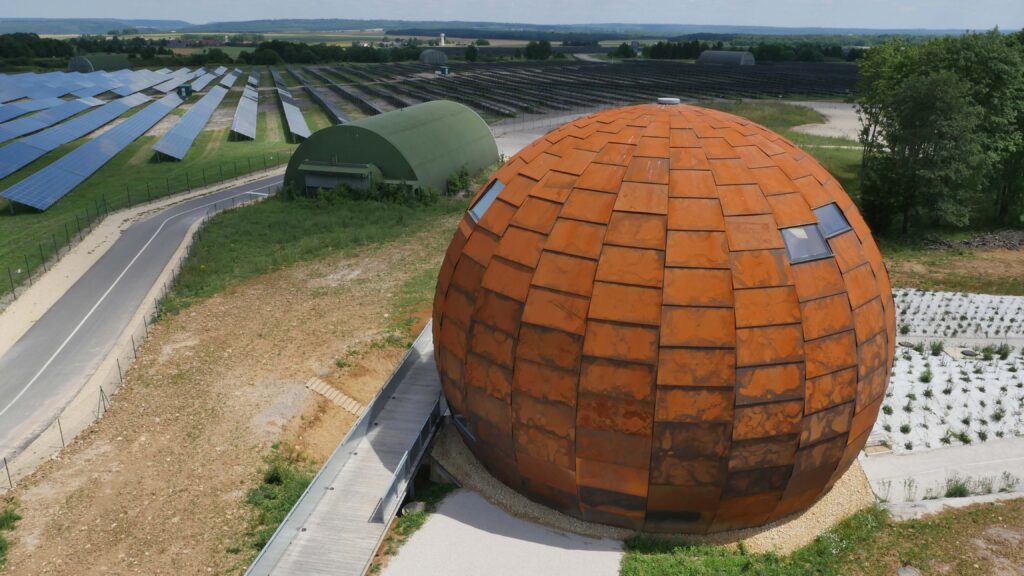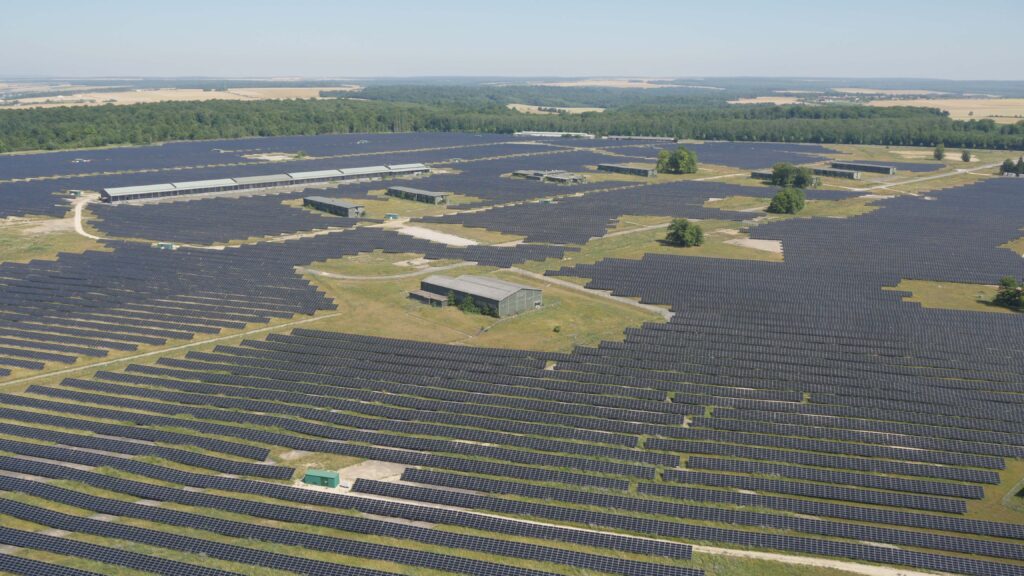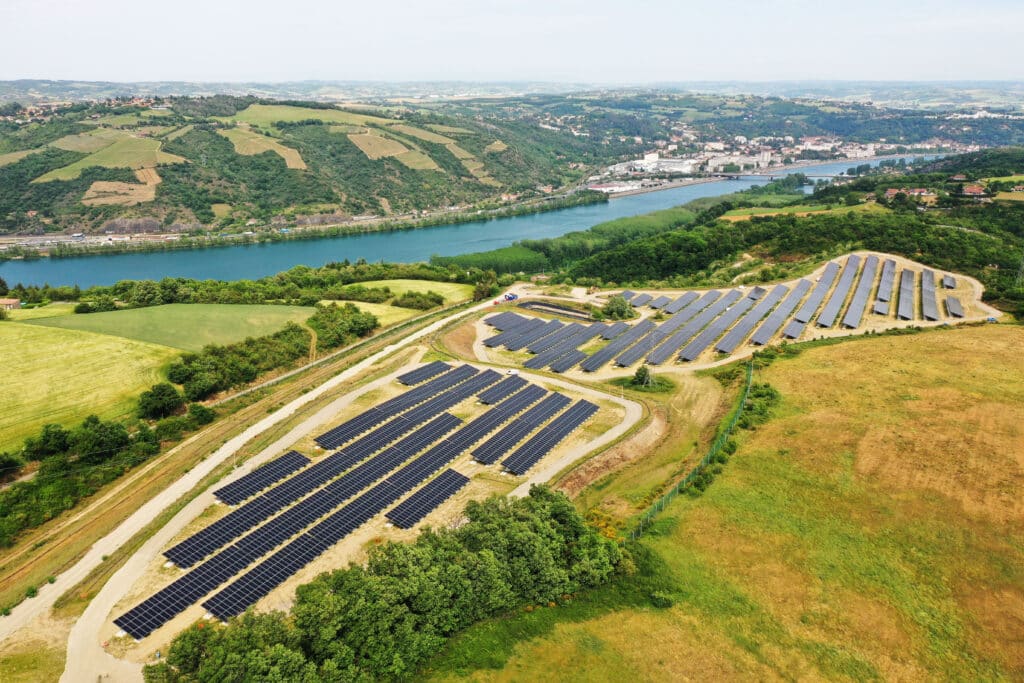Capture the energy released by the sun's rays to produce electricity useful to all, this is the principle of photovoltaic solar energy.
Installed on the roof of houses or municipal buildings, abandoned motorways or even used to shade sheep or vineyards, solar panels produce inexhaustible, low-carbon energy.






A solar panel is a device that uses sunlight to generate electricity. It is made up of several solar cells, which are special little pieces of material called semiconductors. These solar cells are mainly composed of silicon, an element found in sand. When sunlight hits these cells, it is absorbed by electrons in the material.
Sun radiation on photovoltaic modules (1) is transformed into direct electric current routed to an inverter (2).
The inverter converts this electricity into alternating current suitable for the grid.
The transformation station (3) then raises the electrical voltage to make it compatible with the network voltage.
Electricity finally joins the electricity grid (4) via a connection point.
An 18 hectare solar power plant, or around 99,000 panels (12MW), can produce the equivalent of the annual electricity consumption of 6,000 inhabitants.
 Photovoltaic solar, concentrated solar, did you say solar?
Photovoltaic solar, concentrated solar, did you say solar?Solar energy can be captured in several different ways:
 ) than when water is left in the sun in summer.
) than when water is left in the sun in summer.  How to build a photovoltaic solar power plant?
How to build a photovoltaic solar power plant?It typically takes 5 years to develop a ground-mounted solar project.
First of all, we look for a suitable location for the project. Then, we carry out studies to prepare a complete file (impact study) which will be submitted to the authorities. We also discuss the project with the people concerned on the ground: associations, local elected officials, local residents, etc.
We apply for a building permit and prepare the file for review. Once the project is funded, we can build it.

 Focus
Focus 
Today, the recycling rate of a photovoltaic solar panel is estimated at nearly 94% based on crystalline silicon with aluminum frame. Recycling has been a regulatory obligation in France since 2012.
In France, for each purchase of solar panel, EDF Renewables must pay an eco-contribution which guarantees reprocessing of these panels at the end of their life.
SOREN is the approved eco-organization for the collection and recycling of used photovoltaic solar panels.
While it is important to accelerate the development of renewable energies such as photovoltaic solar energy, this must not be done to the detriment of natural spaces and biodiversity!
We therefore favor the installation of solar panels on what we call “artificialized” land, that is to say land that is already used by man. Installing a solar power plant can be an opportunity to reuse and give a second life to unused land, or even a polluted wasteland.. This is the case for former disused air bases and even former waste dumps, which host solar power plants!

In Dijon, EDF Renewables commissioned a solar power plant on the site of a former CET (Technical Landfill Center) which treated the city's waste and on which rubble and residue from construction sites were stored.

Before building a solar power plant, we study the environment and biodiversity over several seasons. This helps us understand the issues of the site and take them into account in the design of the project.
We also observe how animals move around the site and study the different plants that grow there.
These different studies then allow us to design the power plant using the ERC method, which aims to Avoid, Reduce or Compensate where applicable, the effects of the project on the environment.

 Focus
Focus  Let the butterflies pass! 🦋
Let the butterflies pass! 🦋 Near Guéret, in the Creuse, discover how we have preserved an ecological corridor in the middle of the solar power plant to allow butterflies and reptiles to cross the site.
In recent years, we have also seen the development of a new type of solar power plants, floating solar power plants!
Installed on artificial water reservoirs, such as dam lakes, irrigation reservoirs or even drinking water reservoirs, these new type of power plants make it possible to produce low-carbon electricity, while limiting evaporation. of this precious resource that is water!
In France, LThe Lazer floating solar power plant in the Hautes-Alpes was commissioned in 2023. The electrical production of the solar panels complements the electrical production of the hydraulic dam on which the panels are installed, rather clever!
Throughout the world, EDF also benefits from recognized experience on similar projects located on irrigation reservoirs, particularly in Israel.
Reconciling agriculture, animal welfare and photovoltaic solar production is the principle of what we call agrivoltaism!
For several years, EDF Group researchers and experts have been working to develop innovative and tailor-made solutions.
Among the advantages, solar panels can protect crops from climatic hazards such as hail or frost. They can also shade vines or livestock.

 Focus
Focus 

Near Bordeaux, we are working with many players in the wine industry to set up an innovative agrivoltaic demonstrator: Vitisolar!
Over a period of 5 years, this new type of demonstrator will make it possible to study the coexistence of solar panels on vine cultivation.
A solar power plant produces renewable, low-carbon energy, but that’s not all! A solar power plant can also give new life to a degraded, polluted or unused site.. It is also an opportunity for local authorities such as town halls to benefit from new taxes and economic benefits.
Finally, this benefits the dynamism of the territory, which thus shows its commitment to the energy transition!

 Focus
Focus 
Near Nancy, we celebrated the 10th anniversary of our Toul-Rosières solar power plant. Installed on a former NATO air base, the power plant produces annually the equivalent of the electricity consumption of 55,000 inhabitants !
Solar panel : Device that converts sunlight into usable electricity. It is made of solar cells, usually made of silicon, which absorb photons from sunlight and generate an electric current. Solar panels are used to produce renewable energy, helping to reduce dependence on fossil fuels and combat climate change.
electricity : A form of energy that results from the movement of charged particles, called electrons. It can be produced in a variety of ways, including through power plants that use energy sources such as coal, natural gas, wind, solar or water. Electricity is used to power our electrical appliances, light our homes, operate machines and facilitate our communications. It is essential in our daily lives and plays a key role in technological and industrial development.
Consultation : Process of dialogue and discussion between different stakeholders with the aim of making decisions or developing common solutions. It aims to encourage the participation and involvement of all stakeholders, whether individuals, groups, organizations or institutions. Consultation makes it possible to take into account different points of view, find compromises and build a consensus to resolve problems or implement projects in a collaborative and democratic manner.
Biodiversity : Represents the wide variety of living things that exist on Earth, including animals, plants and microorganisms, as well as the different habitats in which they live. It plays a crucial role in maintaining the natural balance, providing essential services and ensuring the well-being of humanity. It is essential to preserve biodiversity to ensure the survival of species and preserve our environment.
Find all the resources available on this theme in the media library
43 Boulevard des Bouvets
CS 90310
92741 NANTERRE CEDEX
©2025 EDF Renewables